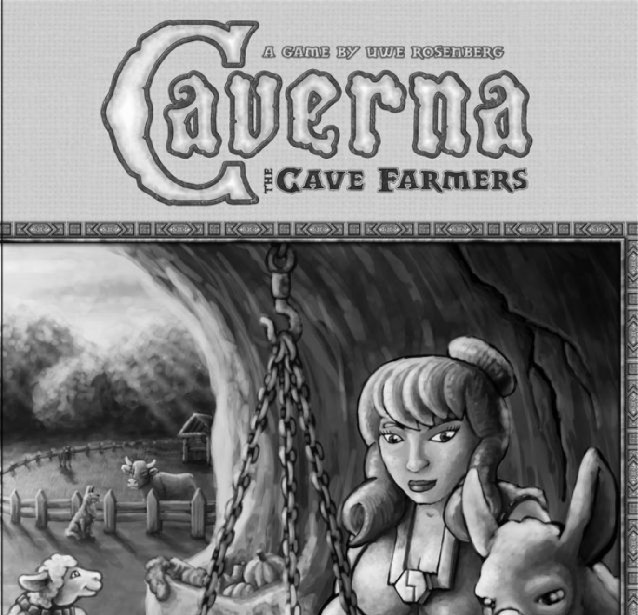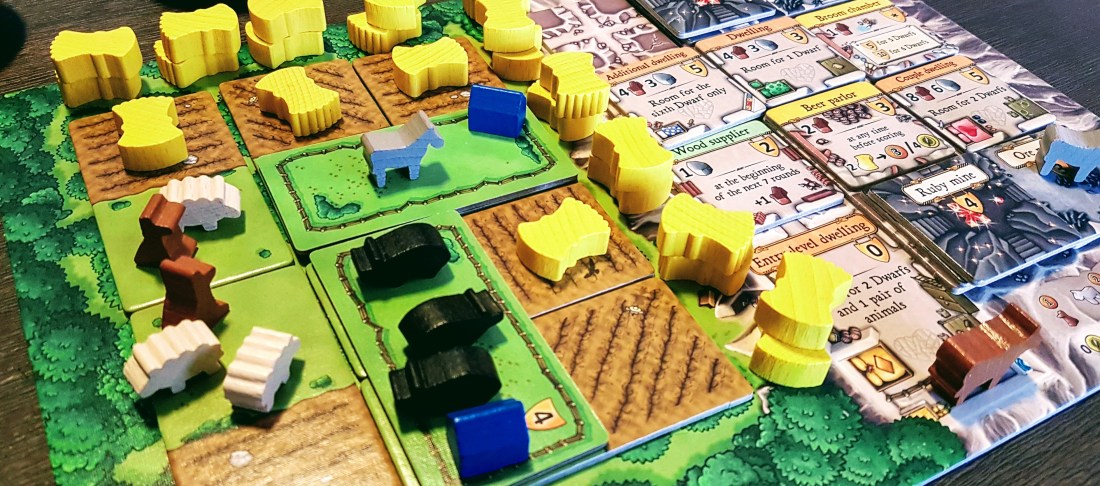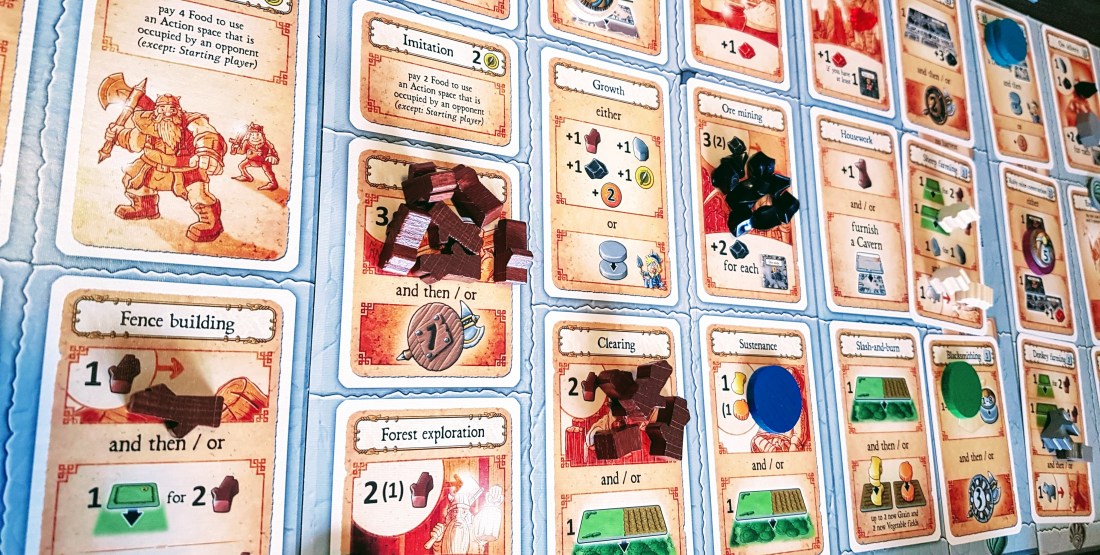
Somewhere deep in the mountains lies a green, fertile valley farmed by dwarfs¹! It seems that practical dwarfs don’t really enjoy eating 100% cave mushrooms, and thus must compromise their cave dwelling desires with a bit of outdoor farming. Of course, the most balanced life requires one to do a little bit of everything, and in order to be the most prosperous family of dwarfs, you will need to find your speciality while still looking after your family.
1-…7 Players| 2-3 Hours| Designed by Uwe Rosenberg
Caverna is the sequel to Uwe Rosenberg’s highly popular game Agricola. While it follows a very similar formula, the gameplay differs in several minor ways that add up to Caverna being a novel experience, rather than simply an expansion. In contrast to Agricola, Caverna feels like much more of a ‘sandbox’ game, with many options and many paths to victory. While a big part of Agricola is keeping your family fed, the overhead of doing this in Caverna isn’t quite as high, meaning you can spend more time feeling like you are achieving something, rather than merely subsisting.

How does it work?
Caverna is a worker placement game with some minor engine building involved. At the beginning of the game, each player has 2 dwarfs (workers) and a blank farm and cave board. Several actions are available from the first round, with a new action being revealed each subsequent round. Actions typically provide resources (wood, stone, food) or allow you to add fields, paddocks, or tunnels to your board. Some actions allow you to add dwellings or special rooms to your caverns.
As the game progresses, new actions will become available. Early on, an action that allows you to go on quests appears. Quests let the player earn ‘loot’, chosen from a number of options based on how cool their dwarf’s hat is. Other new actions let you gain animals, more workers, ore and ruby mines. Late game actions provide more powerful versions of earlier actions.
Points are acquired in a salady fashion, pretty much any action taken in the game will net some points. At the end of the game, animals, grain and vegetables are all worth points, along with furnished rooms and fenced paddocks. As long as you’ve kept your family alive, you will have some points! Serious chunks of additional points can be gained from the gold rooms player can buy – these provide points for collected resources or animals, meeting conditions, or they allow you to convert accumulated goods into points at the end of the game. Developing a mid to late game strategy to take advantage of these rooms is the key to scoring highly and being the most successful dwarf family.

What do I think?
Caverna can be a long and complex game. I’ve played with varying player counts – 2-5 (and I vaguely recall playing with 7 in the distant past…) The game experience can be wildly different with different numbers of players because there are different actions available depending on player count, and resources become more or less plentiful. With that said, it’s hard to judge whether the following comments are coloured by player count variation.
The Good Stuff
- When it comes to worker placement, Caverna is certainly a superb implementation on the mid to heavy end of the scale.
- As a successor to Agricola, Caverna does a great job of remaining familiar while significantly adding to the content and gameplay.
- SO many bits. Like probably 1000 bits at least. The animal meeples are very cute.
- Most actions have a satisfying result. You usually get something tangible every time you do something.
- The mechanic where a new action is added every round means that the non trivial actions are slowly introduced. This is great for newer players as you only need to teach the beginning actions and then one new one each turn.
- Quests are a great way of allowing players to still perform blocked actions (doing a quest gives rewards that can be gotten elsewhere) and add flexibility.
- Resource accumulation is a fun mechanic, and presents interesting trade-off decisions.
The Bad Stuff
- At the beginning of the game, there is pretty much no direction for what players should be trying to do (apart from getting points). This can be especially exasperating for new players and may require some prodding by a more experienced player. I wouldn’t say I’m ‘experienced’ but I’ve played 10+ times, and while there are obvious things to do like getting more workers, starting out it’s hard to see what moves to make.
- There are lots of edge cases in the rules that can be hard to remember (e.g. each animal has slightly different rules). Thankfully, most things are intuitive.
- First player has a significant advantage, especially with such a high cost of taking first player early in the game (it costs an action, which you’ve got two of per round. It’s not worth taking till it has 3-4 food which is 2-3 rounds in)
- There is only one hat making space, which you need to use to go on Quests (more first player advantage).
- There is still a fair bit of that Agricola-esque feeling of wading against the tide when you gotta eat all your new animos and valuable veggies.
- Dogs and wood look too similar. Like, this is legitimately an issue.
- It’s hard to get cows. Why are cows so rare? Why are there like 40 cows provided?
- There are so many rooms, the game stalls anytime someone needs to decide what to get as they are always all available (more overwhelm for new players).
- There is only one of each room in the game. This can be frustrating – it forces races to get obviously powerful rooms, though it does also push players into varied strategies.
- There can be a lot of contention for some actions while others seem under-powered or useless. For example, in some player counts it can feel like there is way too much wood available, or not enough ways to get animals.

Over and under, I really like Caverna. I think it is one of the classic games, and a great example of well executed worker placement. There is a ton of stuff to do, and it’s fairly intuitive – it can be taught to new players in 10 or so minutes and then you can introduce new rules as they are organically brought up in the game. If you like unintentionally blocking your friend’s strategy, hoarding pumpkins and sheep and roleplaying as agriculturally inclined dwarfs, then try out Caverna! It wasn’t #3 on BoardGameGeek for no reason!
¹: Fun fact, I always thought the plural of ‘dwarf’ was ‘dwarves’. When reading the rulebook for Caverna, I was like ‘haha, they think that dwarfs is a word’. I looked it up after the 20th or so time it was used (obviously not a typo at this point). Turns out that ‘dwarfs’ is the plural of ‘dwarf’, and ‘dwarves’ is a word made up by Tolkien for use in the Lord of the Rings because he thought it sounded better than ‘dwarfs’. I agree with Tolkien.

Great review, thanks!! I’m am more excited to play this, it’s in my pile!!
LikeLike